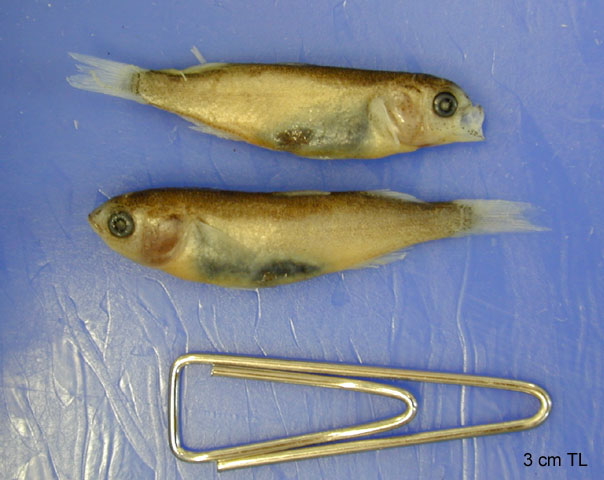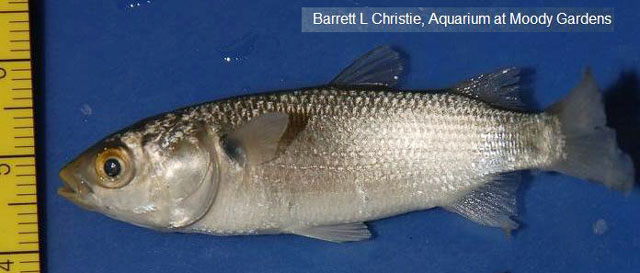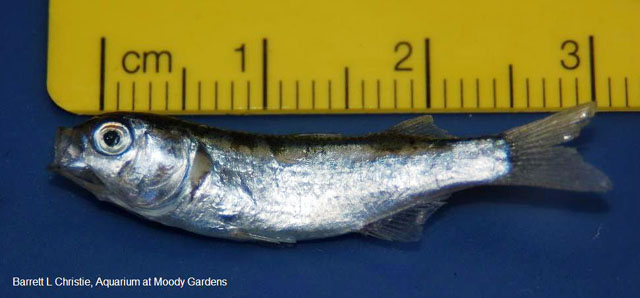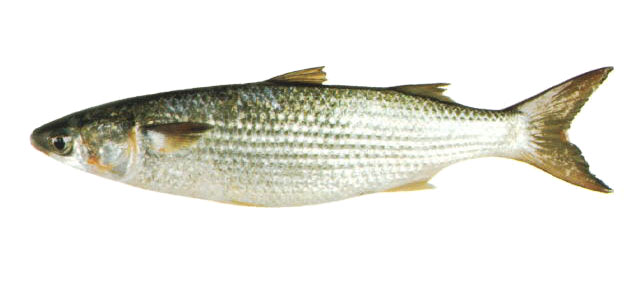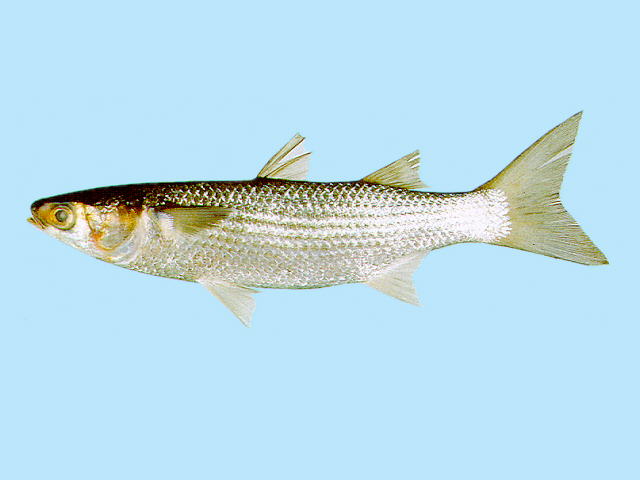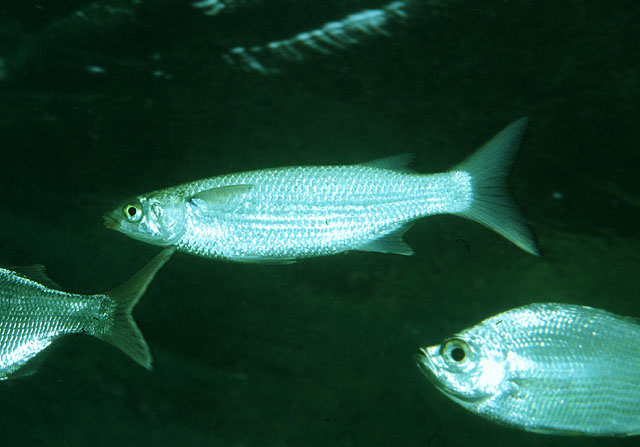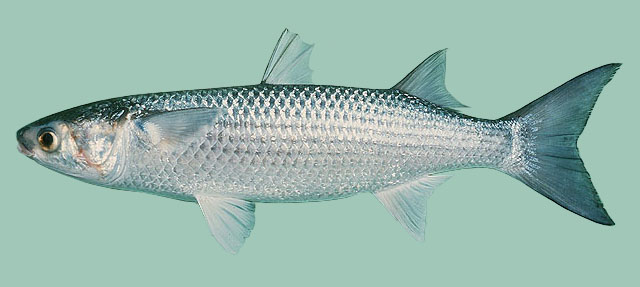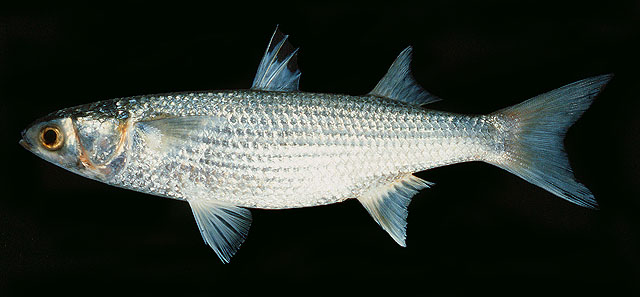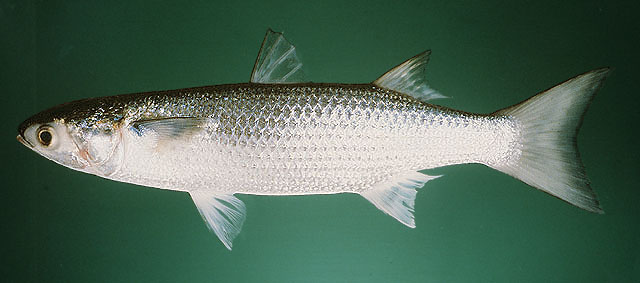Mugil
cephalus
Linnaeus,
1758
Flathead grey mullet
View all media / Upload your photos and videos
Expand all
Classification / Names
Teleostei (teleosts) > Mugiliformes (Mullets) >
Mugilidae (Mullets)
Etymology: Mugil: Latin, mugil, -ilis = grey mullet (Ref. 45335).
cephalus: cephalus meaning head (Ref. 10294).
More on author:
Linnaeus.
Environment / milieu / depth range / climate zone / distribution range
Distribution
Cosmopolitan in coastal waters of the tropical, subtropical and temperate zones of all seas. Eastern Pacific: California, USA to Chile (Ref. 2850). Western Pacific: Japan to Australia (Ref. 9812). Western Indian Ocean: from India to South Africa (Ref. 4393). Western Atlantic: Nova Scotia, Canada to Brazil (Ref. 7251); Cape Cod to southern Gulf of Mexico (Ref. 26938); absent in the Bahamas and most of West Indies and Caribbean (Ref. 7251, 9761). Eastern Atlantic: Bay of Biscay to South Africa, including the Mediterranean Sea and Black Sea (Ref. 7399). Reported in Sea of Okhotsk (Ref. 50550).
Maps
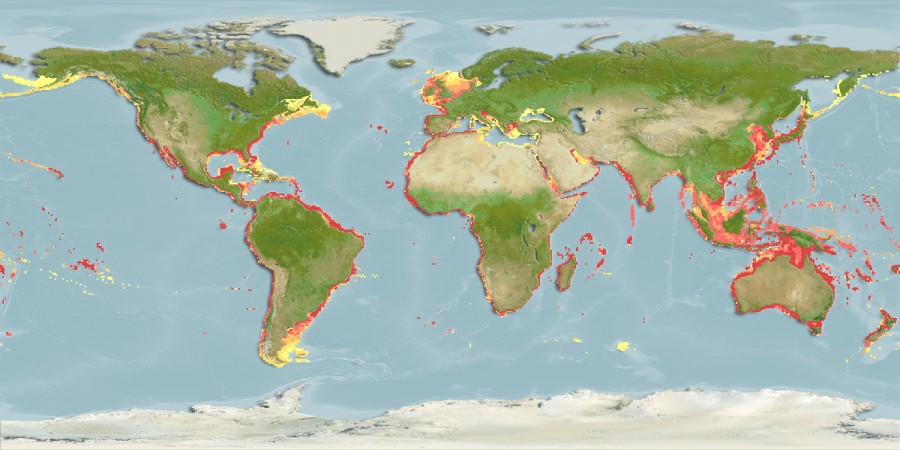
Mugil cephalus / Native range
AquaMaps Data sources:
GBIF
OBIS
This map was computer-generated and has not yet been reviewed.

Mugil cephalus / Suitable habitat
AquaMaps Data sources:
GBIF
OBIS
This map was computer-generated and has not yet been reviewed.

Mugil cephalus / Point map
AquaMaps Data sources:
GBIF
OBIS
This map was computer-generated and has not yet been reviewed.

Mugil cephalus / Year 2050
AquaMaps Data sources:
GBIF
OBIS
This map was computer-generated and has not yet been reviewed.
Length at first maturity / Size / Weight / Age
Short description
Dorsal spines (total): 5; Dorsal soft rays (total): 7 - 9; Anal spines: 3; Anal soft rays: 8 - 9. Diagnosis: body stout, cylindrical in cross-section, slightly compressed; head broad and flattened (Ref. 57400). Well developed adipose eyelid (Ref. 40476, 57400) covering most of pupil (Ref. 57400). Upper lip thin and without papillae (Ref. 57400), with 1-2 outer rows of small, moderately close-set, unicuspid teeth and up to 6 inner rows of smaller, bicuspid teeth (Ref. 81659). Lower lip with outer row of small unicuspid teeth and sometimes 1 or more inner rows of smaller, bicuspid teeth (Ref. 81659). Hind end of upper jaw reaching a vertical line from anterior eye margin; maxillary pad not visible below corner of mouth when closed; origin of 1st dorsal fin nearer to snout tip than to caudal-fin base (Ref. 57400). Anterior parts and bases of 2nd dorsal and anal fins with a moderately dense coverage of scales (Ref. 57400, 81659). Pectoral axillary process (Ref. 57400). 13-15 scale rows between origins of dorsal and pelvic fins (Ref. 57400, 81659). Pelvic fins, anal fin, and lower lobe of caudal fin yellowish in specimens from the tropical Atlantic coast of Africa (Ref. 57400, 81659). Description: lips thin; pectoral fins short (when folded forward does not reach eye); anal spines 3 in adults, anal soft rays 8 in adults, 9 in larvae (Ref. 40476). 36-42 (usually 38 or 39) scales in longitudinal series (excluding scales on caudal fin base); 13-15 scales between pelvic and first dorsal fins; anal fin with 3 spines and 8 (rarely 9) segmented rays in adults (first spine very short and usually hidden by overlying scales), usually 2 spines and 9 soft rays in juveniles <35 mm SL; pectoral fin 61-83% of head length, with 1 short, unsegmented ray dorsally and 15-17 (mode 16) longer, segmented rays; pharyngobranchial organ with single, large valve, often shorter (anteroposteriorly) than deep (dorsoventrally)(Ref. 81659). Coloration: live specimens: dorsally greyish olive, greyish brown (Ref. 81659), bluish-grey (Ref. 57400) to olive-green (Ref. 40476). Flanks silvery(-grey)(Ref. 40476, 57400, 81659) with golden reflections (Ref. 57400) and 7-10 longitudinal dark bands following rows of scales (Ref. 57400, 81659), sometimes distinctive (Ref. 40476), bands less conspicuous on ventral parts of flanks (Ref. 81659). Fish from estuarine waters may have duller flanks and be duller blue or dirty brown dorsally (Ref. 81659). Abdomen off-white (Ref. 40476, 81659). Fins dusky, with numerous fine black speckles, particularly on dorsal and caudal fins; pelvic fins paler than other fins (Ref. 81659). Pelvic fins, anal fin and lower lobe of caudal fin yellowish in specimens from the tropical Atlantic coast of Africa (Ref. 57400, 81659). Dark spot at origin of pectoral fin (Ref. 81659). Preserved specimens: dorsum dark brown, flanks lighter brown or silvery with longitudinal dark bands, and ventral parts of body pale/yellowish or silvery (Ref. 81659).
Biology
Adults are found in coastal waters (Ref. 2850, 44894, 57400), often entering estuaries and rivers (Ref. 2847, 3573, 11230, 44894, 57400), sometimes far-up-river, lagoons and hypersaline environments (Ref. 57400). They are usually in schools over sand or mud bottom (Ref. 2850), between 0 and 10 m, occurring equally in tropical, subtropical and temperate waters (Project MUGIL). They are mainly diurnal, feeding on detritus, micro-algae and benthic organisms (Ref. 56548, 74902, 74760). Juveniles feed on zooplankton until about 3.0 cm SL (Ref. 59043). Reproduction takes place at sea, at various times of the year depending on the location (Ref. 74907Amour). Adults form schools and migrate offshore to spawn and developing larvae migrate back inshore (Ref. 81659). There is absence of an obligatory freshwater phase in the life cycle (Ref. 74752). Females spawn 0.8 to 2.6 million eggs which develop at sea (Ref. 74912Chen & Su 1986). Sexually mature at 3 to 4 years (Ref. 74902). Maximum length reported as 120 cm SL (Ref. 7399, 57400, 81659) remains to be confirmed (Project MUGIL). Maximum weight reported as 12 kg (Ref. 56527) seems too high for the area and remains to be confirmed (Project MUGIL). Widely cultivated in freshwater and brackish ponds (Ref. 2847Jackson 1984, Liao 1981). Marketed fresh, dried, salted, and frozen; roe sold fresh or smoked (Ref. 9321); also used in Chinese medicine (Ref. 12166).
Life cycle and mating behavior
One spawning aggregation was observed in detail. This consisted of five fish, a female and four males. Males would press against the female, which took place as the entire group moved along slowly, facing into a fairly strong tidal flow.
Main reference
Harrison, I.J. 1995 Mugilidae. Lisas. p. 1293-1298. In W. Fischer, F. Krupp, W. Schneider, C. Sommer, K.E. Carpenter and V. Niem (eds.) Guia FAO para Identification de Especies para lo Fines de la Pesca. Pacifico Centro-Oriental. 3 Vols. FAO, Rome. (Ref. 9321)
IUCN Red List Status (Ref. 125652)
Least Concern (LC); date assessed: December 21 2018
CITES (Ref. 131153)
Not Evaluated
CMS (Ref. 116361)
Not Evaluated
Threat to humans
Harmless (Ref. 4887)
More information
- Countries
- FAO areas
- Ecosystems
- Occurrences
- Introductions
- Stocks
- Ecology
- Diet
- Food items
- Food consumption
- Ration
- Common names
- Synonyms
- Metabolism
- Predators
- Ecotoxicology
- Reproduction
- Maturity
- Spawning
- Spawning aggregation
- Fecundity
- Eggs
- Egg development
- Age/Size
- Growth
- Length-weight
- Length-length
- Length-frequencies
- Morphometrics
- Morphology
- Larvae
- Larval dynamics
- Recruitment
- Abundance
- References
- Aquaculture
- Aquaculture profile
- Strains
- Genetics
- Allele frequencies
- Heritability
- Diseases
- Processing
- Mass conversion
- Vision
- Pictures
- Stamps, Coins Misc.
- Sounds
- Ciguatera
- Speed
- Swim. type
- Gill area
- Otoliths
- Brains
Estimates based on models
Preferred temperature (Ref. 123201): 11.3 - 27.9, mean 23.2 °C (based on 3258 cells).
Phylogenetic diversity index (Ref. 82804): PD50 = 0.5 [Uniqueness, from 0.5 = low to 2.0 = high].
Bayesian length-weight: a=0.01202 (0.01084 - 0.01333), b=2.94 (2.91 - 2.97), in cm total length, based on LWR estimates for this species (Ref. 93245).
Trophic level (Ref. 69278): 2.5 ±0.2 se; Based on food items.
Generation time: 4.8 (4.1 - 5.5) years. Estimated as median ln(3)/K based on 20 growth studies.
Resilience (Ref. 120179): Medium, minimum population doubling time 1.4 - 4.4 years (K=0.09-0.15; tm=2-6; tmax=16; Fec=1.6 million).
Prior r = 0.51, 95% CL = 0.34 - 0.77, Based on 12 data-limited stock assessments.
Fishing vulnerability (Ref. 59153): Moderate vulnerability (43 of 100).
Climate vulnerability (Ref. 125649): High vulnerability (59 of 100).
Price category (Ref. 80766): Very high; Reliable: based on ex-vessel price for this species.
Nutrients (Ref. 124155): Calcium = 102 [37, 281] mg/100g; Iron = 1.92 [0.31, 9.44] mg/100g; Protein = 19.6 [18.1, 21.0] %; Omega3 = 0.462 [0.196, 1.091] g/100g; Selenium = 68.3 [27.6, 201.8] μg/100g; VitaminA = 7.56 [2.17, 26.41] μg/100g; Zinc = 1.55 [0.73, 3.87] mg/100g (wet weight); based on nutrient studies.

